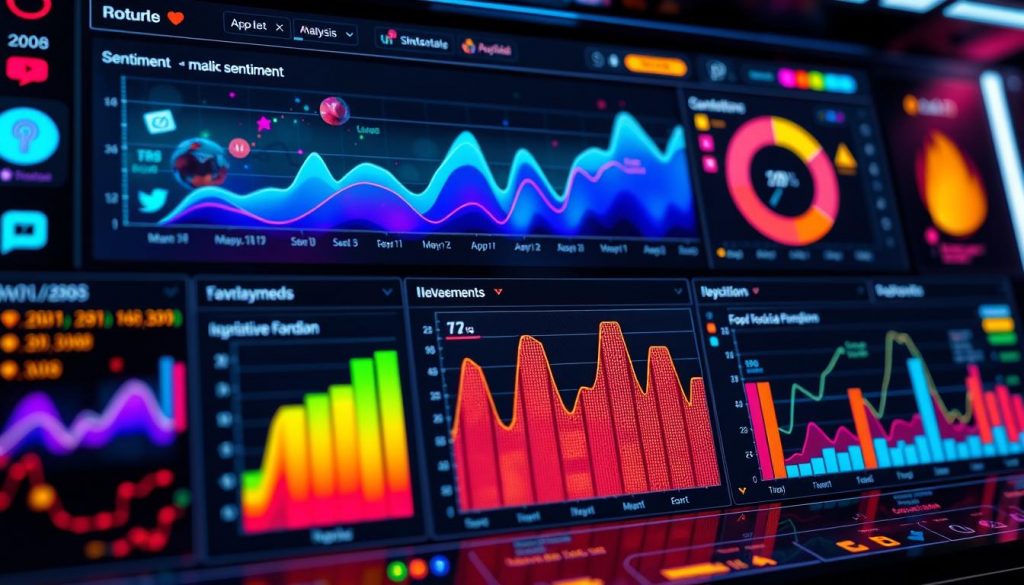Bill Gates once said, “Your most unhappy customers are your greatest source of learning.” This shows how key it is to know what customers think. Social media sentiment analysis lets you track customer feelings in real-time. This helps you make better choices and stay ahead.
Social media tools give insights into using these technologies. They help improve customer service, boost your brand, and grow your business.
With sentiment analysis tools, you can see what customers really think about your brand. You can spot trends and issues early. And make smarter choices for marketing and products.
AI and machine learning make these tools even better. They let you track feelings across many languages and platforms. This means you can analyze customer sentiments in real-time.
Key Takeaways
- Social media sentiment analysis helps you understand customer opinions and preferences.
- Sentiment analysis tools provide real-time tracking and analysis of customer sentiments.
- AI and machine learning power sentiment analysis tools for advanced language processing.
- Social media analytics offer insights into improving customer service and driving business growth.
- Sentiment analysis can identify spikes in negative sentiment, prompting immediate response actions.
- Companies like Domino’s Pizza and Nike have seen significant increases in positive social media sentiment using sentiment analysis tools.
Understanding Social Media Sentiment Analysis
Sentiment analysis is a powerful tool for businesses. It helps them understand what their customers feel and think on social media. By using social media monitoring and sentiment analysis software, companies can learn a lot about their customers. This knowledge can help improve customer service, create better marketing strategies, and boost brand reputation.
One big advantage of sentiment analysis is finding out what customers are unhappy about. By looking at sentiment analysis techniques and social media talks, businesses can see what makes customers happy or upset. This helps them make smart choices and improve their marketing plans.
There are several ways to do sentiment analysis, like text classification, sentiment lexicon, and deep learning models. These methods help businesses understand a lot of data from social media and other places. By using sentiment analysis software and social media monitoring, companies can stay ahead and make good choices about marketing and customer service.
| Technique | Description |
|---|---|
| Text Classification | Classifies text as positive, negative, or neutral |
| Sentiment Lexicon | Uses a dictionary of words with sentiment scores to analyze text |
| Deep Learning Models | Uses machine learning algorithms to analyze complex patterns in text |
The Benefits of Monitoring Social Media Sentiment
Using social media sentiment analysis helps you catch trends and issues early. This way, you can make better marketing and product choices. It involves analyzing emotions and opinions in social media comments to find out if they’re positive, negative, or neutral.
Monitoring social media sentiment has many benefits, including:
- Improved customer understanding and better decision-making
- Higher customer satisfaction by solving problems quickly, which increases engagement
- Finding and fixing issues early, as 60% of customers trust brands that listen to their feedback
With social media analytics, you can track many platforms and gather sentiment data. This helps you make informed decisions. As the global sentiment analysis software market grows, using these tools is key to staying competitive.
| Benefits | Results |
|---|---|
| Improved customer understanding | Enhanced decision-making capabilities |
| Increase in customer satisfaction | Boost in customer engagement |
| Identification of potential crises | Early intervention and issue resolution |
Essential Components of Sentiment Analysis Tools
Choosing the right sentiment analysis software is key. You should look at platform coverage, language needs, and tech stack integration. Good sentiment analysis helps you understand public opinion and make smart choices. Look for tools with advanced data collection, analysis algorithms, and detailed reports.
A top sentiment analysis tool should gather data from Twitter, Facebook, and Instagram. It should also analyze text in many languages. This lets you track sentiment worldwide. Tools like Brand24, Sprout Social, and Talkwalker are great for businesses to monitor their social media.
Data Collection Methods
Data collection is vital for sentiment analysis. It affects how accurate and complete your results are. Choose tools that gather data from social media, review sites, and forums. Some tools also enrich your data with entity recognition and sentiment scoring.
Analysis Algorithms
Analysis algorithms are the core of sentiment analysis. They decide how your data is interpreted and scored. Look for tools with advanced algorithms like machine learning and natural language processing. Some tools let you customize your analysis to fit your needs.
Reporting Features
Reporting features are key to getting the most from your sentiment analysis tool. They help you visualize and share your findings. Choose tools with customizable dashboards, detailed analytics, and data export options. This way, you can use your sentiment analysis data effectively in your workflows.
How to Choose the Right Sentiment Analysis Software
When picking a sentiment analysis tool, think about your language needs. Look for smart NLP that gets context and sarcasm right. Make sure it works well with your current tech stack to make your social media analytics smoother. Social media management tools can help you plan posts, check engagement, and track your social media success.
When choosing a sentiment analysis tool, consider a few important things. It should be able to understand social media sentiment in many languages. It should also be good at catching emotional tones and work with your current social media tools. Top tools can sort social posts and reviews into positive, negative, or neutral, helping you understand customer feedback better.
Here are some things to think about when looking at sentiment analysis tools:
- Language support: Can the tool analyze sentiment in multiple languages?
- Accuracy: How accurate is the tool in detecting emotional tone and sentiment?
- Integration: Can the tool integrate with your existing social media analytics tools?

Choosing the right sentiment analysis tool can give you deep insights into what your customers feel and think. This can help your business grow and make your social media strategy better.
Implementing Social Media Sentiment Analysis in Your Strategy
To use social media sentiment analysis, you need a solid plan. This includes getting, cleaning, and preparing data. Sentiment analysis techniques help you understand what people think about your brand.
With social media monitoring tools, you can keep an eye on what people say about you. This info helps you make better marketing plans and connect with customers. Also, a sentiment analysis API can make analyzing data easier and faster.
- Decide on key metrics to measure how people feel about your brand
- Make analysis workflows to process data quickly and get insights
- Use machine learning to make sentiment detection more accurate
By following these steps and using the right tools, you can make the most of social media sentiment analysis. This helps your business grow by making decisions based on data.
Advanced Sentiment Analysis Techniques
Exploring social media sentiment analysis reveals the value of advanced methods. These methods help uncover detailed emotions and opinions. Sentiment analysis software can spot patterns and trends in online talks. It shows how people feel about current features and what’s missing.
Social media analytics lets you go beyond simple sentiment analysis. You can dive into aspect-based analysis and emotion classification. This way, you can grasp the complexity of customer feelings. It helps you make smart choices and boost your business.
- Improved accuracy in sentiment detection
- Enhanced understanding of customer emotions and opinions
- Ability to identify patterns and trends in online conversations
Using these advanced techniques and sentiment analysis software unlocks the power of social media analytics. You get a deeper insight into your audience’s feelings and opinions.
Interpreting and Acting on Sentiment Data
Understanding sentiment scores is key when using sentiment analysis tools. Scores range from +1 for positive comments to -1 for negative ones. It’s best to normalize these scores to a range like -100 to +100 for clarity.
Sentiment analysis helps spot the most common positive and negative posts about certain keywords. This way, you can see how people feel about your brand. Keeping an eye on social media mentions in real-time is vital for this.
Some main benefits of using sentiment data include:
- Quickly addressing customer concerns
- Making better decisions
- Boosting customer happiness and business success
By using sentiment analysis tools, you can learn a lot about your customers. You can find out what needs improvement and create marketing that really speaks to people. It also helps find the right influencers and check how well your ads are doing.
| Sentiment Type | Description |
|---|---|
| Positive | Shows happiness, approval, or satisfaction |
| Neutral | Has no strong feelings, is impartial |
| Negative | Points out dissatisfaction, complaints, or criticisms |
Common Challenges and Solutions in Sentiment Analysis
Sentiment analysis is a powerful tool for businesses. Yet, it comes with its own set of challenges. One big issue is dealing with sarcasm, irony, and figurative language. These can be tricky for sentiment analysis software to get right.
Another challenge is the complexity of social media analytics. It involves analyzing many languages and keeping data private.
Some common hurdles in social media sentiment analysis include:
- Handling sarcasm and irony
- Analyzing multiple languages
- Ensuring data privacy
To tackle these challenges, businesses can use advanced sentiment analysis software. This software can handle complex language and multiple languages. They can also rely on social media analytics tools for accurate and reliable data.
By using these tools and techniques, businesses can better understand their customers. They can make more informed decisions based on this knowledge.

Conclusion: Maximizing the Value of Social Media Sentiment Analysis
Businesses now heavily use social media for talking to customers, launching products, and sharing big news. The importance of sentiment analysis has grown a lot. It helps you understand what people think and feel about your brand.
With tools that use sentiment analysis API, you can spot trends and what customers like or dislike. This lets you make smart choices and handle problems fast. It’s a way to stay ahead of the competition.
Using sentiment analysis techniques can improve your products and how you talk to customers. It helps you connect better with your audience. Keeping your strategies updated based on this analysis is key to success.











